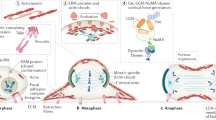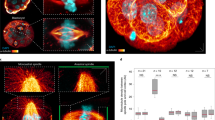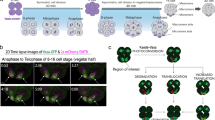Abstract
Cell divisions that create daughter cells of different sizes are crucial for the generation of cell diversity during animal development1. In such asymmetric divisions, the mitotic spindle must be asymmetrically positioned at the end of anaphase2,3. The mechanisms by which cell polarity translates to asymmetric spindle positioning remain unclear. Here we examine the nature of the forces governing asymmetric spindle positioning in the single-cell-stage Caenorhabditis elegans embryo. To reveal the forces that act on each spindle pole, we removed the central spindle in living embryos either physically with an ultraviolet laser microbeam, or genetically by RNA-mediated interference of a kinesin4. We show that pulling forces external to the spindle act on the two spindle poles. A stronger net force acts on the posterior pole, thereby explaining the overall posterior displacement seen in wild-type embryos. We also show that the net force acting on each spindle pole is under control of the par genes that are required for cell polarity along the anterior–posterior embryonic axis. Finally, we discuss simple mathematical models that describe the main features of spindle pole behaviour. Our work suggests a mechanism for generating asymmetry in spindle positioning by varying the net pulling force that acts on each spindle pole, thus allowing for the generation of daughter cells with different sizes.
This is a preview of subscription content, access via your institution
Access options
Subscribe to this journal
Receive 51 print issues and online access
$199.00 per year
only $3.90 per issue
Buy this article
- Purchase on Springer Link
- Instant access to full article PDF
Prices may be subject to local taxes which are calculated during checkout




Similar content being viewed by others
References
Horvitz, H. R. & Herskowitz, I. Mechanisms of asymmetric cell division: two Bs or not two Bs, that is the question. Cell 68, 237–255 (1992).
Rappaport, R. Cytokinesis in animal cells. Int. Rev. Cytol. 31, 169–213 (1971).
Gönczy, P. & Hyman, A. A. Cortical domains and the mechanisms of asymmetric cell division. Trends Cell Biol. 6, 382–387 (1996).
Fire, A. et al. Potent and specific genetic interference by double-stranded RNA in Caenorhabditis elegans. Nature 391, 806–811 (1998).
Sulston, J. E., Schierenberg, E., White, J. G. & Thomson, J. N. The embryonic cell lineage of the nematode Caenorhabditis elegans. Dev. Biol. 100, 64–119 (1983).
Goldstein, B. & Hird, S. N. Specification of the anteroposterior axis in Caenorhabditis elegans. Development 122, 1467–1474 (1996).
Kemphues, K. J. & Strome, S. in C. elegans II (eds Riddle, D. L., Blumenthal, T., Meyer, B. J. & Priess, J. R.) 335–359 (Cold Spring Harbor Laboratory, New York, 1997).
Albertson, D. Formation of the first cleavage spindle in nematode embryos. Dev. Biol. 101, 61–72 (1984).
Leslie, R. J. & Pickett, H. J. Ultraviolet microbeam irradiations of mitotic diatoms: investigation of spindle elongation. J. Cell Biol. 96, 548–561 (1983).
Aist, J. R. & Berns, M. W. Mechanics of chromosome separation during mitosis in Fusarium (Fungi imperfecti): new evidence from ultrastructural and laser microbeam experiments. J. Cell Biol. 91, 446–458 (1981).
Aist, J. R., Liang, H. & Berns, M. W. Astral and spindle forces in PtK2 cells during anaphase B: a laser microbeam study. J. Cell Sci. 104, 1207–1216 (1993).
Waters, J. C., Cole, R. W. & Rieder, C. L. The force-producing mechanism for centrosome separation during spindle formation in vertebrates is intrinsic to each aster. J. Cell Biol. 122, 361–372 (1993).
Wordeman, L. & Mitchison, T. J. Identification and partial characterization of mitotic centromere-associated kinesin, a kinesin-related protein that associates with centromeres during mitosis. J. Cell Biol. 128, 95–104 (1995).
Wein, H., Foss, M., Brady, B. & Cande, W. Z. DSK1, a novel kinesin-related protein from the diatom Cylindrotheca fusiformis that is involved in anaphase spindle elongation. J. Cell Biol. 133, 595–604 (1996).
Desai, A., Verma, S., Mitchison, T. J. & Walczak, C. E. Kin I kinesins are microtubule-destabilizing enzymes. Cell 96, 69–78 (1999).
Gönczy, P. et al. Functional genomic analysis of cell division in C. elegans using RNAi of genes on chromosome III. Nature 408, 331–336 (2000).
Kemphues, K. J., Priess, J. R., Morton, D. G. & Cheng, N. Identification of genes required for cytoplasmic localization in early C. elegans embryos. Cell 52, 311–320 (1988).
Etemad-Moghadam, B., Guo, S. & Kemphues, K. J. Asymmetrically distributed PAR-3 protein contributes to cell polarity and spindle alignment in early C. elegans embryos. Cell 83, 743–752 (1995).
Boyd, L., Guo, S., Levitan, D., Stinchcomb, D. T. & Kemphues, K. J. PAR-2 is asymmetrically distributed and promotes association of P granules and PAR-1 with the cortex in C. elegans embryos. Development 122, 3075–3084 (1996).
Cheng, N. N., Kirby, C. M. & Kemphues, K. J. Control of cleavage spindle orientation in Caenorhabditis elegans: the role of the genes par-2 and par-3. Genetics 139, 549–559 (1995).
Hill, D. P. & Strome, S. An analysis of the role of microfilaments in the establishment and maintenance of asymmetry in Caenorhabditis elegans zygotes. Dev. Biol. 125, 75–84 (1988).
Hyman, A. A. & White, J. G. Determination of cell division axes in the early embryogenesis of Caenorhabditis elegans. J. Cell Biol. 105, 2123–2135 (1987).
Lee, L. et al. Positioning of the mitotic spindle by a cortical-microtubule capture mechanism. Science 287, 2260–2262 (2000).
Korinek, W. S., Copeland, M. J., Chaudhuri, A. & Chant, J. Molecular linkage underlying microtubule orientation toward cortical sites in Yeast. Science 287, 2257–2259 (2000).
Rose, L. S. & Kemphues, K. The let-99 gene is required for proper spindle orientation during cleavage of the C. elegans embryo. Development 125, 1337–1346 (1998).
Brenner, S. The genetics of Caenorhabditis elegans. Genetics 77, 71–94 (1974).
Morton, D. G., Roos, J. M. & Kemphues, K. J. par-4, a gene required for cytoplasmic localisation and determination of specific cell types in Caenorhabditis elegans embryogenesis. Genetics 130, 771–790 (1992).
Gönczy, P. et al. Dissection of cell division processes in the one cell stage Caenorhabditis elegans embryo by mutational analysis. J. Cell Biol. 144, 927–946 (1999).
Raich, W. B., Moran, A. N., Rothman, J. H. & Hardin, J. Cytokinesis and midzone microtubule organization in Caenorhabditis elegans require the kinesin-like protein ZEN-4. Mol. Biol. Cell 9, 2037–2049 (1998).
Powers, J., Bossinger, O., Rose, D., Strome, S. & Saxton, W. A nematode kinesin required for cleavage furrow advancement. Curr. Biol. 8, 1133–1136 (1998).
Acknowledgements
We thank K. Kemphues for mutants it71 and it5; K. Oegema for experimental assistance; A. Desai, E.-L. Florin and E. Hannak for discussions; R. Pepperkok, K. Schütze and R. Schütze for supplying the laser microdissection setup; and T. Bouwmeester, A. Desai, E. Hannak, E. Karsenti, F. Nédélec and K. Oegema for help with improving the manuscript.
Author information
Authors and Affiliations
Corresponding author
Supplementary information
Fig 2a WT and 2b WTirr
Wild-type (left) and wild-type irradiated (right) embryos, 2 frames per second. Spindle poles are indicated by circles, the region where the spindle is severed is indicated by a flashing bar.
Note the increase in pole-to-pole distance following the cut as well as the asymmetry in movement. On average, the posterior spindle pole travels further and faster than the anterior one (Fig. 3). Furthermore, the posterior spindle pole does not come to a rest, it starts to oscillate transversely as it gets close to the cortex.
Fig2c CeMCAK (RNAi)
CeMCAK (RNAi), 2 frames per second, spindle poles are indicated by circles. Note aberrant polar body at the anterior end.
An increase in pole-to-pole distance following spindle breakage as well as asymmetry in movement can be observed. On average, the posterior spindle pole travels further and faster than the anterior one (Fig. 3). Again the posterior spindle pole oscillates transversely as it gets close to the cortex.
Fig 4a
Model a: Aster geometry is similar for both asters, but all posterior microtubules generate greater pulling forces than the anterior ones. As a result, the posterior spindle pole travels faster than the anterior one, but it does not travel further and it does not start to undergo oscillations.
There is no asymmetry in final position, as both spindle poles move to the point of zero net force, which does not change if the force is increased for all posterior microtubules. Aster geometry defines the position of zero net force.
Fig 4b
Model b: All microtubules generate equal pulling forces. Aster geometry is now changed such that the density of microtubules is increased at the posterior end. As a result, the posterior spindle pole now travels faster and further than the anterior one, but still stably positions itself at the point of zero net force, which is now closer to the cortex.
Fig 4c
Model c: All microtubules generate equal pulling forces and aster geometry is similar for both asters. However, as the posterior spindle pole moves, microtubules of the posterior aster detach from the cortex instead of getting longer (dashed microtubules are inactive for 12 seconds). In this scenario all three features are reproduced, as the posterior spindle pole travels further, faster and undergoes transverse oscillations. The anterior spindle pole again stably positions itself at the point of zero net fore.
Furthermore, net forces are balanced in the static situation before spindle severing. Differences are only apparent in the dynamic situation following the cut.
CeMCAK PAR2 double RNAi
2 frames per second, anterior is on the left. Note aberrant polar body at the anterior end.
No breakage visible.
CeMCAK PAR3 double RNAi
2 frames per second, anterior is on the left. Note aberrant polar body coming into focus at the anterior end.
Spindle breakage occurs.
Zen4 phenotype
2 frames per second, anterior is on the left. Note slightly later and less pronounced breakage in comparison to the CeMCAK phenotype (Fig 2c (3.3Mb)).
Rights and permissions
About this article
Cite this article
Grill, S., Gönczy, P., Stelzer, E. et al. Polarity controls forces governing asymmetric spindle positioning in the Caenorhabditis elegans embryo. Nature 409, 630–633 (2001). https://doi.org/10.1038/35054572
Received:
Accepted:
Issue Date:
DOI: https://doi.org/10.1038/35054572
This article is cited by
-
Laser ablation and fluid flows reveal the mechanism behind spindle and centrosome positioning
Nature Physics (2024)
-
The polarity protein PARD3 and cancer
Oncogene (2021)
-
Regionalized tissue fluidization is required for epithelial gap closure during insect gastrulation
Nature Communications (2020)
-
A cell-size threshold limits cell polarity and asymmetric division potential
Nature Physics (2019)
-
Stars take centre stage
Nature Physics (2018)
Comments
By submitting a comment you agree to abide by our Terms and Community Guidelines. If you find something abusive or that does not comply with our terms or guidelines please flag it as inappropriate.



